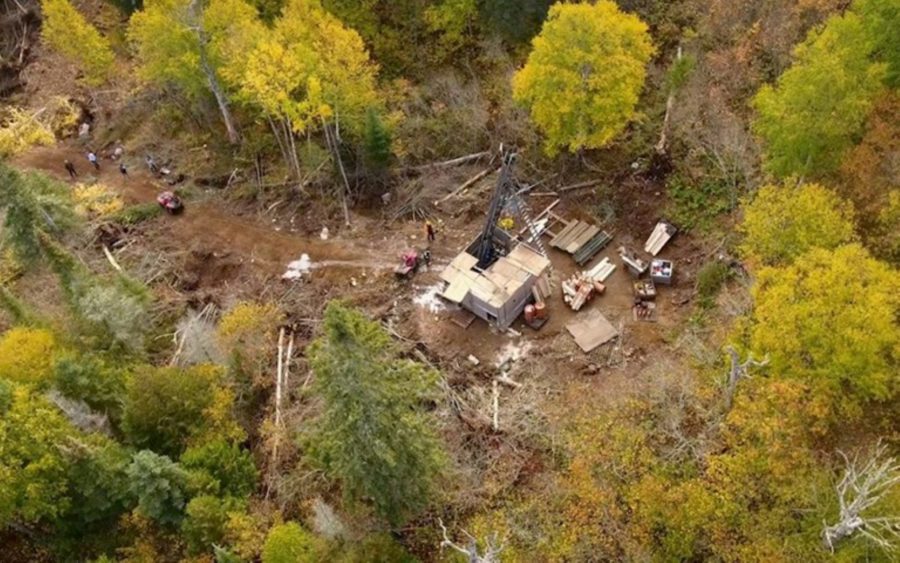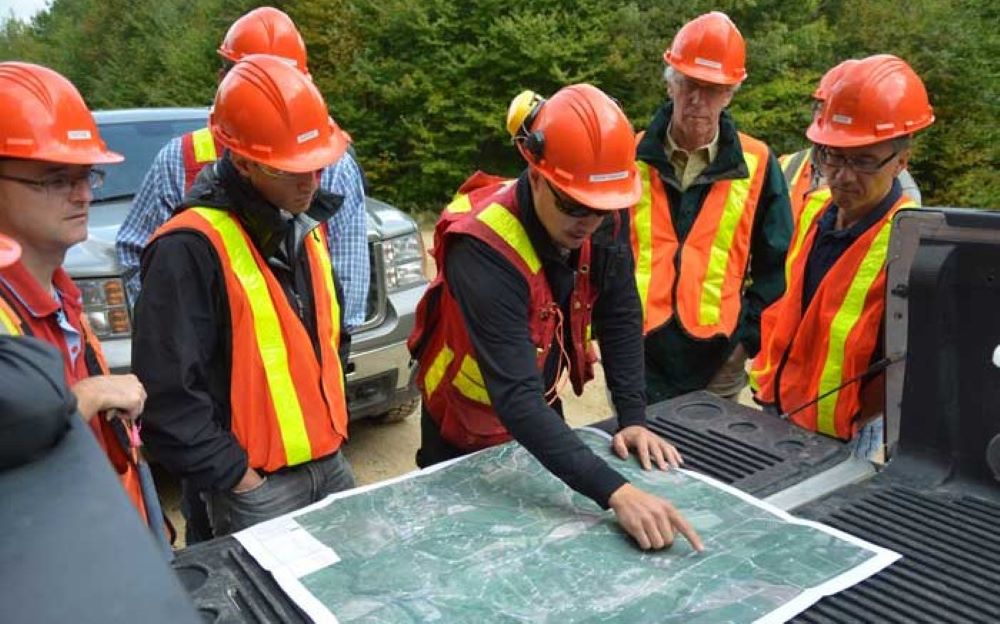Sudbury rolls with the pandemic punches

Hard-Line Solutions technology at the Norcat test mine. Credit: Norcat
At the beginning of the Covid-19 pandemic last March, Norcat CEO Don Duval expected demand for the organization’s services – which are centred on providing a place to develop, test, and buy and sell mining technology – to “come to a grinding halt.”
Instead, in the early days of the pandemic, the Sudbury, Ont.-based, non-profit innovation centre was busier than ever.
“In mid-May to June, we saw a massive increase,” Duval says. For the four months ending in July, Norcat saw its pipeline demand from companies seeking to use its underground test mine for mining technology development and demonstration increase by 500%.
In an interview in January, Duval said that pace has largely continued through the pandemic.
The pop in activity at Norcat continues a trend toward adoption of new technology and innovation in mining that predated the pandemic. That growing interest prompted the organization to invest in a new, $4-million facility, with construction starting in 2019. The official opening of the 12,500-sq.-ft. Norcat Underground Centre, next to the Norcat test mine in Onaping, is slated for March.
Duval believes the pace of new technology development and testing picked up during the pandemic for several reasons. In addition to the ongoing pressure for miners to modernize their operations, the “unprecendented” deployment of capital by the federal government in response to the pandemic also played a part. That capital came from an array of programs – everything from the wage subsidy to FedNor’s Regional Relief and Recovery Fund and the National Research Council of Canada’s Industrial Research Assistance Program (IRAP) – and helped juice activity in startups.
“This cash provided efficient capital to a huge array of technology companies that was used to sustain employment but also further build the business, build reference customers, and enhance product development to get into the market,” Duval says.
In addition, the past five years has seen the rise of venture capital in the mining sector – a pool of capital that simply didn’t exist previously (for example, the Sudbury Catalyst Fund and the Business Development Bank of Canada’s Industrial Innovation Fund).
Moreover, Duval believes the shock of the disruption caused by the pandemic combined with people working from home with fewer distractions, stimulated creativity for many people.
Essential service designation
As part of the unique mining innovation hub that has developed in the Sudbury region, Norcat’s experience can be seen as an indication of an ecosytem that, by and large, has held up well during the pandemic. The one glaring exception of course, is Laurentian University’s filing for creditor protection in early February. While it’s too early to say how Laurentian’s insolvency will affect the complex mining innovation ecosystem in Ontario’s north, there’s little doubt that it will have knock on effects (see sidebar on page 41.)
For the other organizations in that ecosystem, including miners, mine supply companies, and other R&D and academic institutions, the designation of mining as an essential service across Canada and globally has been the biggest factor supporting their relative health.
While Sudbury’s economic development division has been busy helping many local businesses weather the pandemic storm, mining has been somewhat sheltered from those difficulties.
“The mining industry, including supply and services, has not required much if any assistance,” says Brett Williamson, director of economic development for the City of Greater Sudbury.
As for the mine operations, they have risen to the challenges of operating safely during the pandemic.
“They’ve done a phenomenal job in our opinion of bringing the testing into the mine sites and keeping the workers safe. And where there has been the occasional case, they’ve moved quickly to contain any impact,” Williamson says. “They’re probably the best example of any industry right now that has been largely untouched.”
Paul Bradette, executive director of Sudbury mine service and supply organization MineConnect, says the sector’s essential service status has meant that mine supply companies – 300-plus of which are based in the Sudbury region – have been able to continue doing business.
“To a large degree, we have not been impacted like other sectors have,” said Bradette, who ends a three-year term with MineConnect in March (he is returning to the Ministry of Northern Development and Mines after a secondment).
A strong gold price has also helped: “Operators have some cash flow to undertake projects,” he noted.
Still costs have risen as suppliers have adopted safety measures, including spliting shifts to ensure employees can maintain enough distance, purchasing PPE, installing physical dividers in work spaces, and sending employees out on service calls in separate vehicles to maintain distance.
Government funding available to help defray PPE purchase costs has helped some MineConnect members, as has the wage subsidy. Programs such as the Covid-19 Technology Adoption Fund, which provides federal grants to help companies upgrade their online infrastructure and adopt new digital tools to service customers remotely, have also proven useful.
Those tools have been important to survival as quarantine regulations make travel impractical for most suppliers, who already are short of skilled people, Bradette says.
“If you sell a piece of equipment and you send someone to site for a week to help install it, with a quarantine of 14 days you lose that person for almost a month,” he notes.
In some cases, it’s made sense for suppliers to adopt a virtual approach. For example, they may need to guide a local mechanic in Mexico or Chile in repairing a piece of equipment for a client.
“A number of our companies have adopted some new technology, have spent some money to upgrade that – which is an enabler for them to do these things,” Bradette says.
For Lively, Ont.-based Maestro Digital Mines, the situation has been reversed: the disruption of the pandemic has forced its clients to adopt digital communication technology they were previously reluctant to use.
The company, which makes environmental sensors and easy-to-install hardware that allows digital communications at the mine face, has long used such digital communication technologies internally.
“We were well engaged with all these tools, but our clients weren’t – they didn’t appreciate that type of engagement,” says Maestro’s vice-president of marketing and sales, Michael Gribbons.
Now, the company’s clients have come around. In fact, Maestro just had its best year yet in terms of sales and profits.
That said, it’s been tough to build new relationships in parts of the world such as Latin America, where a personal touch and face-to-face meetings are part of the cultural expectations.
But the positives for the company, which is celebrating 10 years in business this year, have so far outweighed the negatives. Working from home has made the entire Maestro team more productive, Gribbons says, including some members who had previously spent half their time on the road. “We’re not going back to the old ways so easily.”
Charging ahead
The rise of battery electric vehicles affords another unique advantage for Sudbury as it’s both a source of battery minerals (including nickel and copper) and a growing hub of BEV mining equipment suppliers.
Both Glencore’s US$700-million Onaping Depth project and Vale’s $760-million Copper Cliff Deep expansions include the adoption of battery electric fleets.
Meanwhile, Cambrian College and Collège Boréal have both put together training programs for BEV maintenance –
reinforcing the region’s rising expertise in BEVs. In January, Cambrian announced a training and applied research partnership with MacLean Engineering, that includes a BEV maintenance course for heavy duty technicians already working in the mining sector. And in February, Collège Boréal and Epiroc announced the start of a joint program to provide BEV maintenance training.
Cambrian College has also announced plans to build a $2.8-million BEV lab at its Centre for Smart Mining.
In February, the City of Sudbury committed $250,000 towards the lab, with the college hoping for another $2 million in funding from the federal and provincial governments.
“The global market for BEVs is expected to grow to $17.5 billion by 2025,” said Brian Bigger, mayor of Greater Sudbury, commenting on the funding announcement. “I am proud to say that Sudbury is one of the early adopters of BEV technology and by offering specialized training and education, we will soon become the global hub for everything related to BEVs.”





Comments